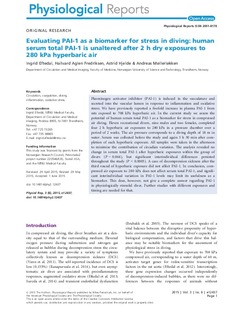Evaluating PAI-1 as a biomarker for stress in diving: human serum total PAI-1 is unaltered after 2 h dry exposures to 280 kPa hyperbaric air
Journal article, Peer reviewed
Permanent lenke
http://hdl.handle.net/11250/299784Utgivelsesdato
2015Metadata
Vis full innførselSamlinger
Sammendrag
Plasminogen activator inhibitor (PAI-1) is induced in the vasculature and secreted into the vascular lumen in response to inflammation and oxidative stress. We have previously reported a fivefold increase in plasma PAI-1 from rats exposed to 708 kPa hyperbaric air. In the current study we assess the potential of human serum total PAI-1 as a biomarker for stress in compressed air diving. Eleven recreational divers, nine males and two females, completed four 2 h hyperbaric air exposures to 280 kPa in a pressure chamber over a period of 2 weeks. The air pressure corresponds to a diving depth of 18 m in water. Serum was collected before the study and again 3 h 30 min after com- pletion of each hyperbaric exposure. All samples were taken in the afternoon to minimize the contribution of circadian variation. The analysis revealed no change in serum total PAI-1 after hyperbaric exposures within the group of divers (P = 0.064), but significant interindividual differences persisted throughout the study (P < 0.0005). A case of decompression sickness after the third round of hyperbaric exposure did not affect PAI-1. In conclusion, com- pressed air exposure to 280 kPa does not affect serum total PAI-1, and signifi- cant interindividual variation in PAI-1 levels may limit its usefulness as a biomarker. This does, however, not give a complete answer regarding PAI-1 in physiologically stressful dives. Further studies with different exposures and timing are needed for that.
